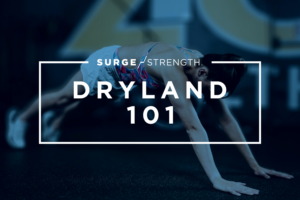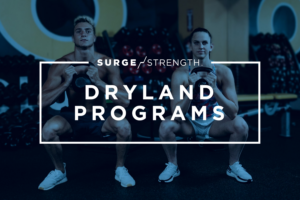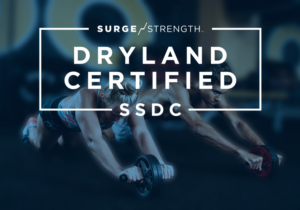Individualizing dryland training is a critical skill coaches need to learn in order to see success in their dryland program. When working with a team of swimmers, there is no one-size-fits-all dryland plan. Some athletes need to go back to basics. Others get bored because they need more of a challenge. Unfortunately for coaches, time is of the essence and accommodating every swimmer during a workout isn’t always the best idea. After all, you still have to coach the workout itself in addition to programming it. This doesn’t leave much margin to change a plan mid-session, or to pull athletes aside for 1 on 1 assistance. Therefore, you need a system that gives you the right exercises in your back pocket for athletes of various training abilities.
SURGE Strength offers a practical solution to this problem. We assess athletes in 5 main categories of movement. Then, we use this data to categorize them into “levels” for each of our exercises.
Individualizing Dryland Training with Assessments to “Level Up”
Deciding which level, or category, each athlete falls into for each exercise is not chosen at random. Each result in the corresponding assessment matches a level in our exercise bank for that specific movement category. In a previous article, we discussed the benefits of exercise assessments as well as the factors that go into conducting reliable exercise testing. The athlete’s assessment results directly correspond to level 1, 2, or 3 respectively. It’s important to note that while athletes may be ready to level up in some exercises, they may need to stay at level 1 for others.
Individualizing Dryland Training for Each Swimmer
Keep in mind that athletes can level “down,” in addition to leveling “up.” Perhaps an athlete is rehabbing an injury. Simply move from level 2 exercises back to level 1 until they regain the strength to safely return to their baseline. In other instances, some athletes benefit from regressing an exercise if they are simply lacking coordination in a particular movement pattern. Giving a level 1 baseline option is a great way to modify training for more advanced athletes. Additionally, it keeps swimmers from being benched through an injury.
The 5 Movement Categories for Individualizing Dryland Training
A comprehensive dryland plan challenges movement in all planes and directions. The 5 main movement patterns we consider when creating a dryland plan are: bracing, pulling, pushing, squatting, and hinging. Below, we give a brief description of each movement category. Then, provide just one example of how to level up a dryland exercise for each of these essential categories.
1) The Brace
Bracing refers to the ability an athlete has to maintain proper positioning by using their core. The core transfers energy from one extremity to the other. A proper brace is not only important to achieve good swimming mechanics, but also a prerequisite for proper technique in other movements categories as well.
Below, we use the front bridge, otherwise known as a plank, as our baseline exercise to brace. Then, we progress to an opposite bridge where athletes lift opposite arms and legs in the plank position. This takes core stability to a new level as the athlete works to maintain the flat back position with just 1 arm and 1 leg on the ground.
Level 1 – Front Bridge
–Subscribe to the SURGE Strength YouTube Channel
Level 2 – Opposite Plank
–Subscribe to the SURGE Strength YouTube Channel
2) The Pull
Pulling is crucial to a swimmer’s stroke as well as preventing shoulder injuries. To learn more about the pull, check out our previous article where we break down the importance of both horizontal and vertical pulling actions.
Use the pull-up assessment to determine which level is best for an athlete to train. We use the flexed arm hang as a baseline movement to increase strength at the top of the pull-up first. Then, we progress our swimmers to working pull-ups once their assessment improves. It’s important to mention that you can easily create an in-between option by using a band for assistance.
Level 1 – Flexed-Arm Hang
–Subscribe to the SURGE Strength YouTube Channel
Level 2 – Pull-up
–Subscribe to the SURGE Strength YouTube Channel
3) The Push
Both vertical and horizontal pushing are great for athletes to build strength for the catch. It’s very important to master fundamental pushing exercises before throwing more advanced variations into the plan. This way swimmers avoid shoulder injury. On the other hand, it’s important that athletes who test into Level 2 or 3 push exercises take advantage of the opportunity to train hard. Ironically, coaches who shy away from incorporating “the push” often find that their athletes are weak in the shoulders, which also increases risk of injury. Assessments paired with categorizing pushing exercises takes the guess work out of the “risk vs reward” factor when it comes to pushing exercises.
Below, we progress a basic pushup by elevating the feet. This puts more weight into the core and upper body as the athlete pushes away from the floor.
Level 1 – Push-up
Level 2 – Decline Push-up
4) The Squat
Every time an athlete turns in the pool or dives off the blocks, they are essentially performing a squat. However, not everyone’s squat mobility nor ability is the same. It’s important to progress both double and single leg versions of this exercise accordingly for best results.
Below, we start by weighting the squat in the front of the body. This helps the athlete improve their depth and control their center of gravity throughout the movement. When they are ready for level 2, we advance them to the back squat. In this more challenging variation, the athlete is challenged to keep their chest up while maintaining depth in the traditional squat position.
Level 1 – Goblet Squat + KB
Level 2 – Back Squat + BB
5) The Hinge
Hinging is often the most underrated movement category in dryland. However, the hips drive almost every athletic movement a swimmer performs. If coaches try to progress the hinge too quickly, athletes often suffer from lower back pain. By using the Trapbar Deadlift as a Level 1 exercise, swimmers keep the load more directly under their body until they master a proper hinging position. Once they have the grip strength, upper back engagement, and hinge form perfected, they can advance to a Romanian Deadlift. This exercise puts the load out in front of the swimmer forcing them to recruit more of their posterior chain to safely move the weight.
Level 1 – Trapbar Deadlift
Level 2 – Romanian Deadlift + BB
Using this level system is extremely effective because it allows you to work off of 1 individualized dryland program even when training many athletes. As situations arise throughout the season, you can scale the sessions without compromising the overall dryland plan. Likewise, you don’t have to worry about changing the set-up, equipment, or flow of the workout when training levels are diverse. You simply tailor the movement of choice to match each athlete’s individual ability and get back to coaching. Using the level system of progressed and regressed exercises to match your athlete’s assessment data is your secret weapon to efficient dryland programming.
MORE DRYLAND RESOURCES FROM SURGE STRENGTH:
ENROLL IN A DRYLAND 101 COURSE FOR FREE
GET STARTED WITH A DRYLAND PROGRAM
LEARN ABOUT BECOMING SSDC

SURGE Strength’s Mission:
BUILD BETTER ATHLETES
GENERATE FASTER SWIMMERS
Courtesy of SwimSwam’s exclusive dryland training partner, SURGE Strength.
SURGE Strength is swim-specific, strength training by Chris Ritter, whose aim is to build better athletes and faster swimmers through SURGE Strength’s Dryland Programs, Courses and Certification.










